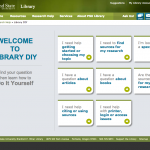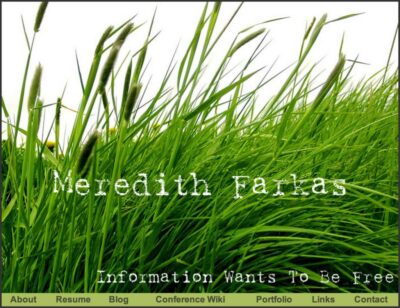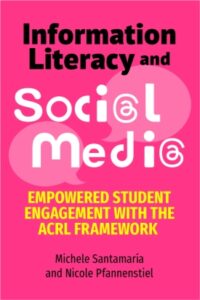One year ago, I became our General Education Instruction Coordinator, which meant that I was in charge of our instruction to Freshman Inquiry and Sophomore Inquiry (our first and second year general education courses), 100 and 200-level writing classes, Speech classes, and the Intensive English Language Program. Last summer, I wrote about the new model we were adopting for our Freshman Inquiry (FRINQ) instruction. This new model was based on the sense we had that our one-shot model of instruction was not giving Freshmen enough support for successfully completing their research assignments, and, while we couldn’t increase our instruction to FRINQ, we needed to help weave information literacy instruction into the fabric of their classes. The basic gist of our model was this:
1. Learning objects and learning activities for face-to-face and online instruction and assessment (you can see our faculty/peer-mentor-facing LibGuide, which is far from an ideal format for serving up this info). These were designed to give faculty and peer-mentors the tools they need to support student research skills development. The learning objects are short and modular and can be combined in various ways to meet the unique needs of each class. Essentially, this is library instruction in a box, but a box that can be readily customized for each class. We spent the bulk of last summer creating this content. It was a slog, pfew!
2. A train-the-trainer approach for peer-mentors (and, to some extent, faculty). The library was a part of the peer mentor (students in their Junior or Senior years who’d been nominated by faculty to be mentors) training, so we had an early opportunity to make them aware of the resources available to them. Throughout the year, we also reminded the peer-mentors that we were available to meet with them individually to help them create lesson plans for teaching research skills. For faculty, we had the opportunity to meet with them before the start of Fall term and introduce the new resources we’d created for their use. Each librarian is assigned a certain group of FRINQ classes, and they marketed what we could do for the classes at the start of every term (FRINQ is a year-long program)
3. Pushing the idea of a “warmth session.” Rather than teaching “information literacy” content, this 20-minute session in the students’ classroom was focused on library awareness and putting a friendly human face on the library. This was based on the research of Constance Mellon on library anxiety.
4. Offering to create a LibGuide for each section of FRINQ. We had previously only created guides by request or if we were teaching in the classroom, but this year, we tried to work with faculty and/or mentors to develop LibGuides that were tailored to their course requirements. For classes whose faculty/mentors didn’t work with us, we had a general FRINQ LibGuide.
5. Separate drop-in library workshops for mentors and FRINQ students. For the mentors, these were offered early in the term and for the FRINQ students, they were offered shortly before the time that research papers were coming due.
So, how did it go? On the whole, the project was a success. Many faculty and mentors used the instructional content and activities we’d created and mentors felt more supported by the library. We did a survey of faculty and mentors at the end of Spring term and found that, on the whole, faculty and mentors were very positive about the support they received from the library. We did a lot of warmth sessions in the Fall term and those seemed to go quite well. It makes sense early on for a library session to be focused on what the library has to offer and I think we made a good case for students to take advantage of our services and collections.
Just as we’d expected, things didn’t go exactly as we’d hoped. While our goal had been to meet with every mentor individually to support them in their support of student research skills development, we found that many mentors ignored our offers of help. We did work with a fair number of the mentors, but, for many classes, our primary contact was still the instructor. Some instructors even asked their mentors to contact the librarian assigned to them and they didn’t, which reminded me of the old adage “you can lead a horse to water…”. This year I learned that there is a great diversity in the role mentors play in Freshman Inquiry. In some cases, the mentors are the only ones teaching research skills to students during the year. In other cases, faculty wouldn’t dream of trusting an undergraduate peer mentor with that role. In most cases, it seems to be a blend; the faculty member teaches research skills and the peer-mentor emphasizes what they’ve learned and provides more in-depth support in the mentor sessions. There is also great diversity in terms of the skill level of the mentor; some already were well-equipped to support student research by virtue of the training they had in their own major. The interactions we did have with mentors (either on-on-one or in the workshops we offered) were very positive and I was touched to receive a thank-you card from the mentors this year.
We also didn’t create course guides for every FRINQ, which I’d anticipated and for which I’d created the general FRINQ guide. We created individual course guides for around 60% of the FRINQ classes, which I consider a success and I hope we’ll increase that percentage next year. Here’s an example of what one of our course guides looked like (though they were all very different depending on the course requiements and the librarian creating the guide).
In spite of the fact that we were trying to move away from them, we still ended up teaching plenty of traditional one-shot infolit sessions. I honestly didn’t have a problem with that. Many of the faculty members teaching in FRINQ are department chairs, emerita, and senior faculty in their departments. If they have a specific expectation of what the librarian’s role in the class is, they’re going to ask for it. And chances are good that we’re not going to say no. Our goal was not to stop teaching one-shots, but to make our teaching and outreach more meaningful, which I think we accomplished. But those same faculty were very open to our warmth session model and I found that I had a much more receptive audience in the one-shot when it was my second visit with the class than when I was coming in cold. I also tried some interesting flipped models for instruction which I think helped to increase the student commitment and the relevance of the session to them (I plan to write an article about that soon).
The one thing that was an out-and-out failure was offering drop-in workshops to the FRINQ students before their research papers were due. I didn’t expect many people to show up, but, for most of our workshops, no one did. When it comes to workshops outside of the curriculum, I’m of the belief that it’s usually worth trying to see if there’s a demand, marketing the heck out of them, and then retooling or dropping them based on what you discover. In this case, this simply isn’t worth our time to offer. As I’d assumed, for Freshman, if it isn’t a required part of their class, they’re not going to seek it out.
All-in-all, I feel like our increased outreach to mentors as well as to faculty was the best part of what we did this past year. The online tools we provided them with were perceived as very valuable and helped to take information literacy instruction beyond the library session for those faculty and mentors who may not have felt equipped to teach it on their own. Next year, my hope is that we will continue to market the warmth sessions, that we will continue our outreach to the mentors, and that we will continue creating course guides for each FRINQ. We’re still going to be a part of the mentor training and I’m going to try to get on the Faculty Retreat agenda again. This summer we’re also going to be assessing Freshman Inquiry portfolios from this past year to get a sense of where students are with their research skills in different FRINQ themes. We’re using a rubric we developed this Spring (which I am also very proud of — thanks to the Library FRINQ Team for helping develop it and to Megan Oakleaf for beating best practices for rubric design into me). This is the first large-scale assessment the library has done (other than participating in RAILS for which we never received the results) and I’m looking forward to making changes to our approach to FRINQ based on what we learn from student work.
It’s been a good year and I’m immensely proud of what we’ve accomplished. I’m confident that with assessment data, we’ll do even better work next year.
Image credit: Break free by aussiegall, on Flickr”







Thanks for the report! I’ve been wondering how it all went. Lot of good ideas here.
There is so much here I want to try at MPOW. Thank you for sharing!
Thanks John and Barbara! Please let me know if you have any questions.
Pingback: Why I Teach Freshman | Information Wants To Be Free
Pingback: Our new model for Freshman instruction and how ...